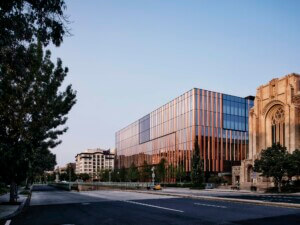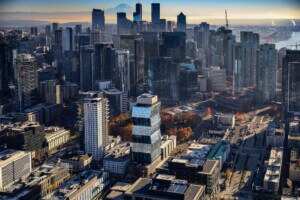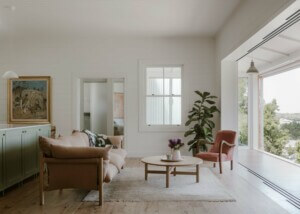Architect: KoningEizenberg Architecture
Location: Melbourne, Australia
Completion Date: February 2023
Los Angeles–based design studio KoningEizenberg Architecture (KEA) has completed construction on a new student pavilion for the University of Melbourne in Victoria, Australia. Circulation on the new concrete building was pushed to the exterior, which is detailed with extruded balconies, wood cladding, and glazing.
The new pavilion is one component of the larger Student Precinct, a massive project which encompasses the renovation of seven university buildings and the surrounding landscape—almost 200,000 square feet of space.

The precinct was designed and master planned by a collaborative group of firms which included Lyons, KEA, NMBW Architecture Studio, Greenaway Architects, Architects EAT, Aspect Studios, and Glas Urban. These firms were awarded the commission after participating in a competition organized by the university
Prior to the competition, the University of Melbourne conducted surveys and research through a series of arts festivals, workshops, and design presentations to determine what spaces would be relevant to students. Students cited difficulty establishing community at the University of Melbourne and requested non-academic spaces to facilitate friendship and leisure.
Nathan Bishop, principal at KEA, told AN, “The University of Melbourne set about creating a new generous and varied setting for student life that would best serve their 54,000 plus students (nearly 40 percent from overseas) at a time when there is a keen awareness of the issue of social isolation on campuses around the world. The majority of students commute to campus and there was an obvious need for more on-campus informal study and recreational space.”

Responding to the brief, KEA sought to design a space that would be more inviting than the austere mid-century and colonial academic buildings which dot the campus. The building’s circulation has been pushed to the exterior—large stairwells, and generously spaced balconies wrap the pavilion. Besides facilitating movement through the building, the balconies also function as hangout spaces, and contain tables, benches, and chairs to cultivate socialization.

The facade itself, which is shaded by the extruded balconies, consists of alternations in wood cladding and glazing, depending on solar orientation. Due to conditions south of the equator, buildings in Australia receive strong sunlight along their northern elevation, requiring a reduced window-wall ratio. KEA was able to implement a larger glazed area along the shaded southern elevation which conveniently faces the campus.
The University had concerns about student safety across the three levels of balconies. To avoid the implementation of stiflingly high balustrades, which would have prevented views and enclosed the balcony, KEA draped a wire-mesh net over the balconies, which ensured safety, while remaining semi transparent. The stainless steel net was attached to the roof and connected to stanchions located underneath the balconies.

Australian blackbutt timber was specified to clad the opaque portions of the facade, chosen by the firm because of its local availability and resiliency, given the frequency of wildfires in Southern Australia.
Structurally, the pavilion’s precast concrete superstructure was left exposed, with columns rising through the space. The columns were cast in right trapezoidal forms that alternate across floors in a reference to the campus’s existing Brutalist architecture. The concrete skeleton was cast and formed offsite.
KEA used supplementary cementing materials, such as fly ash and blast slag, to reduce cement usage by 30 percent. The team was also able to reclaim 50 percent of the water used during the hydration process.

Photovoltaic panels were installed across the roof of the pavilion, and the outdoor patio on top of the building. Above the patio, the panels double as shading elements. Segments of the roofline are sloped in section, allowing for the inclusion of clerestory windows which bring filtered light into the pavilion.
KEA’s Student Pavilion was certified Green Star Six by the Green Building Council of Australia, the country’s equivalent of LEED platinum.

The Student Pavilion provides a new home for the Rowden White Library, which was previously housed within the university’s Student Union. This facility, known colloquially as rowdy, is a non-academic library which was established during the student protest movement in the late 1960s. The library’s motto—“please do not study”—has been scrawled across one of the pavilion’s concrete columns.
The Student Precinct project was undertaken within the guidelines of the University of Melbourne’s Reconciliation Action Plan. According to the plan, the project aims to achieve “greater recognition of Indigenous cultures and heritage as part of the University infrastructure developments.” The masterplan of the precinct provides for a new facility which will house the Murrup Barak Melbourne Institute for Indigenous Development.
Reconciliation was also approached through the precinct’s landscaping strategy. According to Bishop, the concept centered around “recovering a pre-colonial landscape.” This meant a departure from the heavy manicured landscapes which typify higher education campuses. The landscape design was completed in collaboration with Indigenous architect Jefa Greenaway, director of Greenaway Architects.
Project Specifications
-
- Architect: KoningEizenberg Architecture
- Architect of Record: Lyons Architecture
- Associate Architects: Lyons Architecture, Breathe Architecture, NMBW Architecture, Greenaway Architects, Architects EAT
- Structural, Civil Engineering: WSP
- Facade Engineering: BG&E
- Code, Fire Engineering: Dobbs Doherty
- MEP, Fire, Lighting: Lucid Consulting
- Sustainability: Aurecon
- Acoustics: Marshall Day
- Landscape Architects: Aspect Studios, Glas Urban
- Low Voltage/AV: UT Consulting
- Facade Access: Altitude
- General Contractor: Kane Constructions
- Stainless Steel Net: Jakob
- Curtain Wall and Timber Rainscreen: Minesco
- Glazing: AVIC Glass











